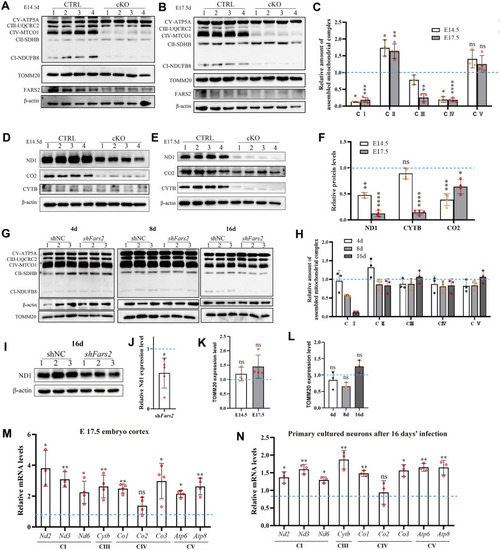Fig. 5
- ID
- ZDB-FIG-220715-34
- Publication
- Chen et al., 2022 - Neuropathy-associated Fars2 deficiency affects neuronal development and potentiates neuronal apoptosis by impairing mitochondrial function
- Other Figures
- All Figure Page
- Back to All Figure Page
|
Translation and assembly of OXPHOS subunits are disrupted in Fars2-deficient samples. A–C Western blotting for OXPHOS complexes and the mitochondrial marker TOMM20 in control and cKO mice embryo cortex at indicated embryonic ages (mean ± SD; two-tailed unpaired t-Test, ns: non-significant; *P < 0.05; **P < 0.01; ***P < 0.001; ****P < 0.0001; n = 4). D–F Western blotting for ND1, CO2 and CYTB in control and cKO mice embryo cortex at the indicated embryonic ages (mean ± SD; two-tailed unpaired t-Test, ns: non-significant; *P < 0.05; **P < 0.01; ***P < 0.001; ****P < 0.0001; n = 4). G–H Western blotting for OXPHOS complexes and the mitochondrial marker TOMM20 in control and Fars2 knocked-down neurons at the indicated days of culture (mean ± SD; two-tailed unpaired t-Test, ns: non-significant; *P < 0.05; n = 3). I–J Western blotting for ND1 in control and Fars2 knocked-down neurons at 16 days of infection (mean ± SD; two-tailed unpaired t-Test, *P < 0.05; n = 3). K–L Quantification of TOMM20 in A, B and G (mean ± SD; two-tailed unpaired t-Test, ns: non-significant; n = 3–4). M RT-PCR analysis of OXPHOS subunits transcription levels in control and cKO mice embryo cortex at E 17.5 (mean ± SD; Two-tailed unpaired t-Test, ns: non-significant; *P < 0.05; **P < 0.01; n = 3–4). N qRT-PCR analysis of OXPHOS subunits transcription levels in control and Fars2 knocked-down neurons at 16 days after infection (mean ± SD; Two-tailed unpaired t-Test, ns: non-significant; *P < 0.05; **P < 0.01; n = 3) |

